LEAP-Based Greenhouse Gases Emissions Peak and Low Carbon Pathways in China’s Tourist Industry
Abstract
1. Introduction
2. Materials and Methods
2.1. LEAP-Tourist Model
2.2. Scenario Design
2.3. Time Series Trend Prediction Method
2.4. Data Collection
3. Tourism Revenue Forecast
3.1. Order Parameter Identification
3.2. U Value Calculation
3.3. Trend Forecast
4. Results
4.1. Energy Demand Forecast
4.2. GHG Emissions
4.3. Emission Reduction Contribution
5. Discussion
6. Conclusions
Author Contributions
Funding
Institutional Review Board Statement
Informed Consent Statement
Conflicts of Interest
References
- Wang, S.; Zhou, L. Integrated impacts of climate change on glacier tourism. Adv. Clim. Chang. Res. 2019, 10, 71–79. [Google Scholar] [CrossRef]
- Gössling, S. National emissions from tourism: An overlooked policy challenge? Energy Policy 2013, 59, 433–442. [Google Scholar] [CrossRef]
- Lin, J.; Kang, J.; Khanna, N.; Shi, L.; Zhao, X.; Liao, J. Scenario analysis of urban GHG peak and mitigation co-benefits: A case study of Xiamen City, China. J. Clean. Prod. 2018, 171, 972–983. [Google Scholar] [CrossRef]
- Liu, Z.; Guan, D.; Moore, S.; Lee, H.; Su, J.; Zhang, Q. Steps to China’s carbon peak. Nature 2015, 522, 279–281. [Google Scholar] [CrossRef] [PubMed]
- Shaheen, K.; Zaman, K.; Batool, R.; Khurshid, M.A.; Aamir, A.; Shoukry, A.M.; Sharkawy, M.A.; Aldeek, F.; Khader, J.; Gani, S. Dynamic linkages between tourism, energy, environment, and economic growth: Evidence from top 10 tourism-induced countries. Environ. Sci. Pollut. Res. 2019, 26, 31273–31283. [Google Scholar] [CrossRef]
- Tang, C.; Zhong, L.; Ng, P. Factors that Influence the Tourism Industry’s Carbon Emissions: A Tourism Area Life Cycle Model Perspective. Energy Policy 2017, 109, 704–718. [Google Scholar] [CrossRef]
- Qi, Y.; Stern, N.; He, J.; Lu, J.; Liu, T.; King, D.; Wu, T. The policy-driven peak and reduction of China’s carbon emissions. Adv. Clim. Chang. Res. 2020, 11, 65–71. [Google Scholar] [CrossRef]
- Bi, C.; Zeng, J. Nonlinear and Spatial Effects of Tourism on Carbon Emissions in China: A Spatial Econometric Approach. Int. J. Environ. Res. Public Health 2019, 16, 3353. [Google Scholar] [CrossRef]
- Wu, P.; Han, Y.; Tian, M. The measurement and comparative study of carbon dioxide emissions from tourism in typical provinces in China. Acta Ecol. Sin. 2015, 35, 184–190. [Google Scholar] [CrossRef]
- Tang, M.; Ge, S. Accounting for carbon emissions associated with tourism-related consumption. Tour. Econ. 2018, 24, 510–525. [Google Scholar] [CrossRef]
- Perch-Nielsen, S.; Sesartic, A.; Stucki, M. The greenhouse gas intensity of the tourism sector: The case of Switzerland. Environ. Sci. Policy 2010, 13, 131–140. [Google Scholar] [CrossRef]
- Sharp, H.; Grundius, J.; Heinonen, J. Carbon Footprint of Inbound Tourism to Iceland: A Consumption-Based Life-Cycle Assessment including Direct and Indirect Emissions. Sustainability 2016, 8, 1147. [Google Scholar] [CrossRef]
- Gössling, S. Sustainable Tourism Development in Developing Countries: Some Aspects of Energy Use. J. Sustain. Tour. 2000, 8, 410–425. [Google Scholar] [CrossRef]
- Becken, S.; Frampton, C.; Simmons, D. Energy consumption patterns in the accommodation sector—the New Zealand case. Ecol. Econ. 2001, 39, 371–386. [Google Scholar] [CrossRef]
- Becken, S. Analysing International Tourist Flows to Estimate Energy Use Associated with Air Travel. J. Sustain. Tour. 2002, 10, 114–131. [Google Scholar] [CrossRef]
- Becken, S.; Simmons, D.G.; Frampton, C. Energy use associated with different travel choices. Tour. Manag. 2003, 24, 267–277. [Google Scholar] [CrossRef]
- Becken, S.; Patterson, M. Measuring National Carbon Dioxide Emissions from Tourism as a Key Step Towards Achieving Sustainable Tourism. J. Sustain. Tour. 2006, 14, 323–338. [Google Scholar] [CrossRef]
- Wu, P.; Shi, P. An estimation of energy consumption and CO2 emissions in tourism sector of China. J. Geogr. Sci. 2011, 21, 733–745. [Google Scholar] [CrossRef]
- Robaina, M.; Moutinho, V.F.; Costa, R. Change in energy-related CO2 (carbon dioxide) emissions in Portuguese tourism: A decomposition analysis from 2000 to 2008. J. Clean. Prod. 2016, 111, 520–528. [Google Scholar] [CrossRef]
- Meng, W.; Xu, L.; Hu, B.; Zhou, J.; Wang, Z. Quantifying direct and indirect carbon dioxide emissions of the Chinese tourism industry. J. Clean. Prod. 2016, 126, 586–594. [Google Scholar] [CrossRef]
- Dubois, G.; Ceron, J.P. Tourism/Leisure Greenhouse Gas Emissions Forecasts for 2050: Factors for Change in France. J. Sustain. Tour. 2006, 14, 172–191. [Google Scholar] [CrossRef]
- Peeters, P.; Dubois, G. Tourism travel under climate change mitigation constraints. J. Transp. Geogr. 2010, 18, 447–457. [Google Scholar] [CrossRef]
- Emodi, N.V.; Emodi, C.C.; Murthy, G.P.; Emodi, A.S.A. Energy policy for low carbon development in Nigeria: A LEAP model application. Renew. Sustain. Energy Rev. 2017, 68, 247–261. [Google Scholar] [CrossRef]
- Yang, D.; Liu, B.; Ma, W.; Guo, Q.; Li, F.; Yang, D. Sectoral energy-carbon nexus and low-carbon policy alternatives: A case study of Ningbo, China. J. Clean. Prod. 2017, 156, 480–490. [Google Scholar] [CrossRef]
- Ates, S.A. Energy efficiency and CO2 mitigation potential of the Turkish iron and steel industry using the LEAP (long-range energy alternatives planning) system. Energy 2015, 90, 417–428. [Google Scholar] [CrossRef]
- Hu, G.; Ma, X.; Ji, J. Scenarios and policies for sustainable urban energy development based on LEAP model—A case study of a postindustrial city: Shenzhen China. Appl. Energy 2019, 238, 876–886. [Google Scholar] [CrossRef]
- Nieves, J.; Aristizábal, A.; Dyner, I.; Báez, O.; Ospina, D. Energy demand and greenhouse gas emissions analysis in Colombia: A LEAP model application. Energy 2019, 169, 380–397. [Google Scholar] [CrossRef]
- Hong, S.; Chung, Y.; Kim, J.; Chun, D. Analysis on the level of contribution to the national greenhouse gas reduction target in Korean transportation sector using LEAP model. Renew. Sustain. Energy Rev. 2016, 60, 549–559. [Google Scholar] [CrossRef]
- Grizane, T.; Jurgelane-Kaldava, I. Tourist Transportation Generated Carbon Dioxide (CO2) Emissions in Latvia. Environ. Clim. Technol. 2019, 23, 274–292. [Google Scholar] [CrossRef]
- Tan, X.; Dong, L.; Chen, D.; Gu, B.; Zeng, Y. China’s regional CO2 emissions reduction potential: A study of Chongqing city. Appl. Energy 2016, 162, 1345–1354. [Google Scholar] [CrossRef]
- Zhang, J.; Zhang, Y. Carbon tax, tourism CO2 emissions and economic welfare. Ann. Tour. Res. 2018, 69, 18–30. [Google Scholar] [CrossRef]
- Saidi, K.; Hammami, S. The impact of CO2 emissions and economic growth on energy consumption in 58 countries. Energy Rep. 2015, 1, 62–70. [Google Scholar] [CrossRef]
- Dong, F.; Pan, Y. Evolution of Renewable Energy in BRI Countries: A Combined Econometric and Decomposition Approach. Int. J. Environ. Res. Public Health 2020, 17, 8668. [Google Scholar] [CrossRef] [PubMed]
- Lee, L.; Wang, Y.; Zuo, J. The nexus of water-energy-food in China’s tourism industry. Resour. Conserv. Recycl. 2021, 164, 105157. [Google Scholar] [CrossRef] [PubMed]
- People’s Daily. A Total of 637 Million Domestic Visitors Received during the Eight-Day Holiday. Available online: https://baijiahao.baidu.com/s?id=1679979206979069040&wfr=spider&for=pc (accessed on 23 January 2021). (In Chinese).
- Göessling, S.; Peeters, P. ‘It Does Not Harm the Environment!’ An Analysis of Industry Discourses on Tourism, Air Travel and the Environment. J. Sustain. Tour. 2007, 15, 402–417. [Google Scholar] [CrossRef]
- Lin, T. Carbon dioxide emissions from transport in Taiwan’s national parks. Tour. Manag. 2010, 31, 285–290. [Google Scholar] [CrossRef]
- Tang, C.; Zhong, L.; Fan, W.; Cheng, S. Energy consumption and carbon emission for tourism transport in World Heritage Sites: A case of the Wulingyuan area in China. Nat. Resour. Forum. 2015, 39, 134–150. [Google Scholar] [CrossRef]
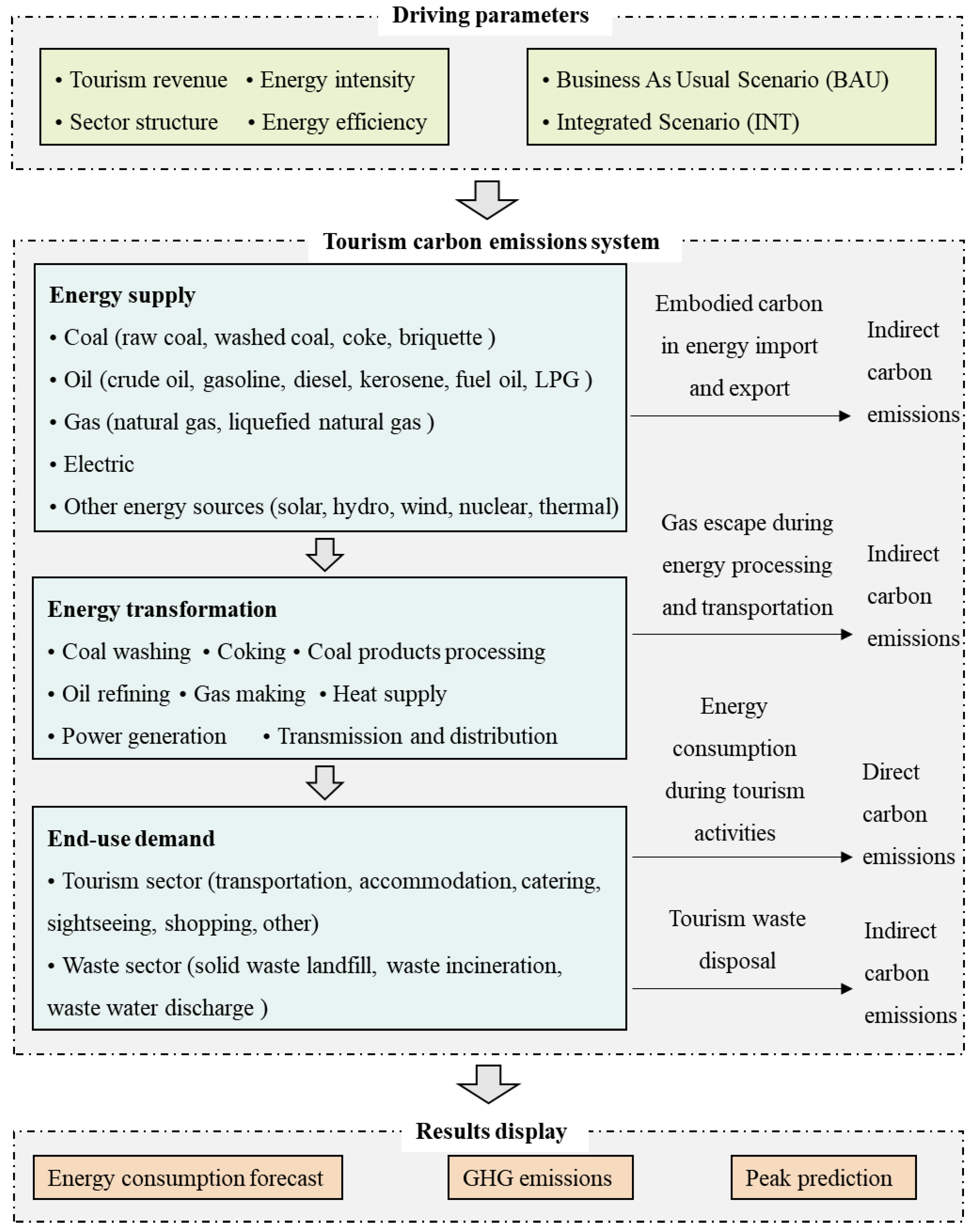
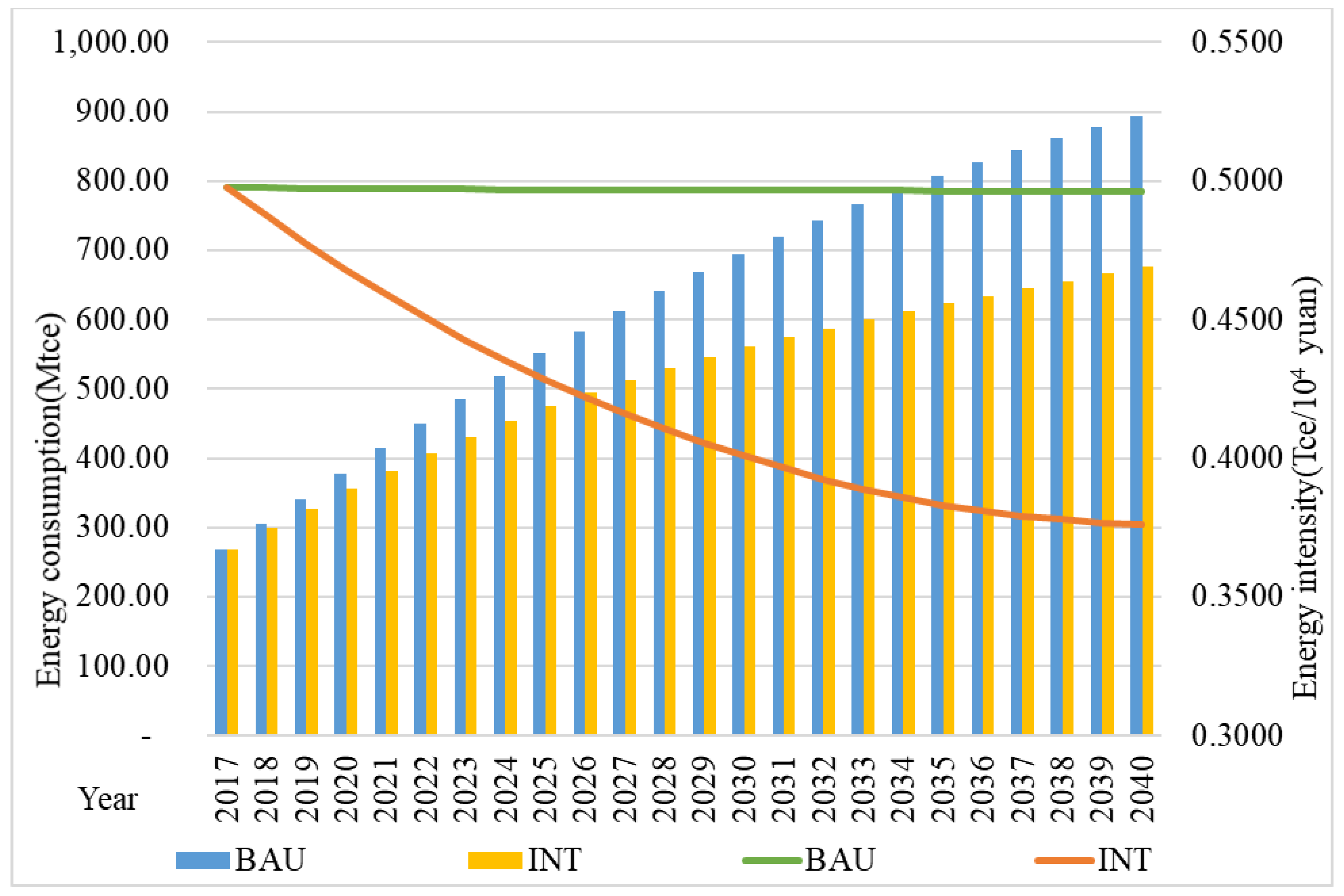
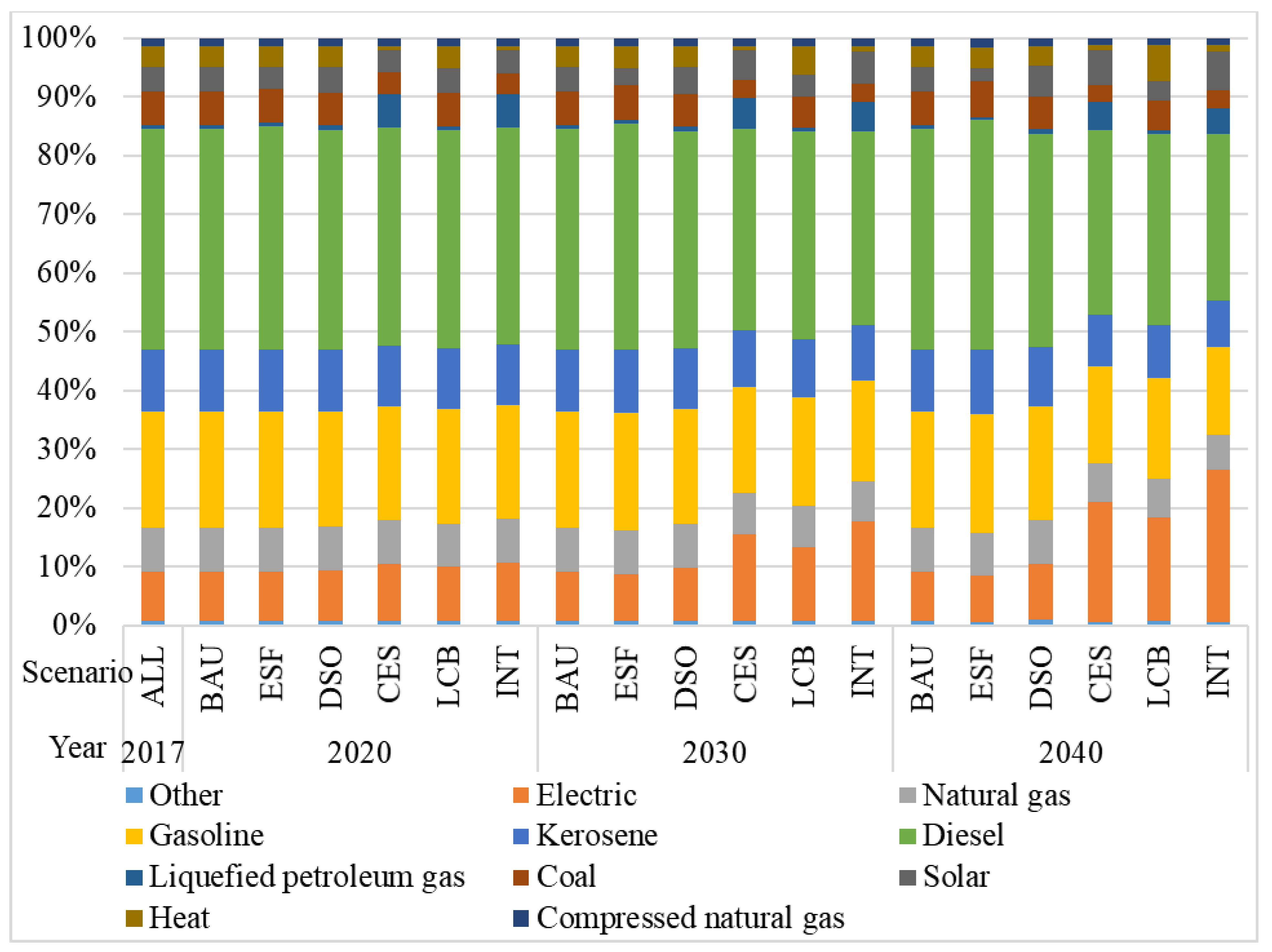
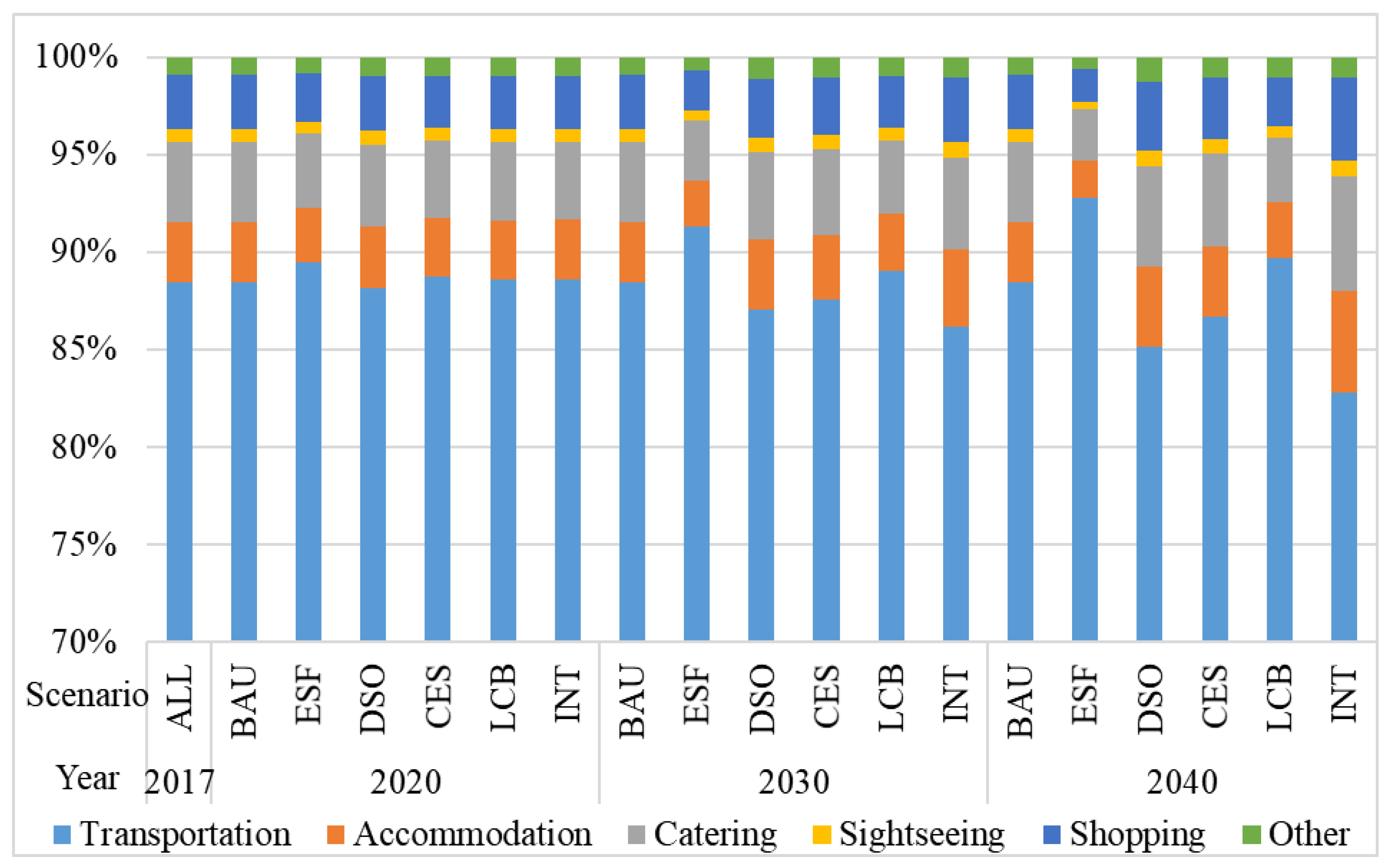
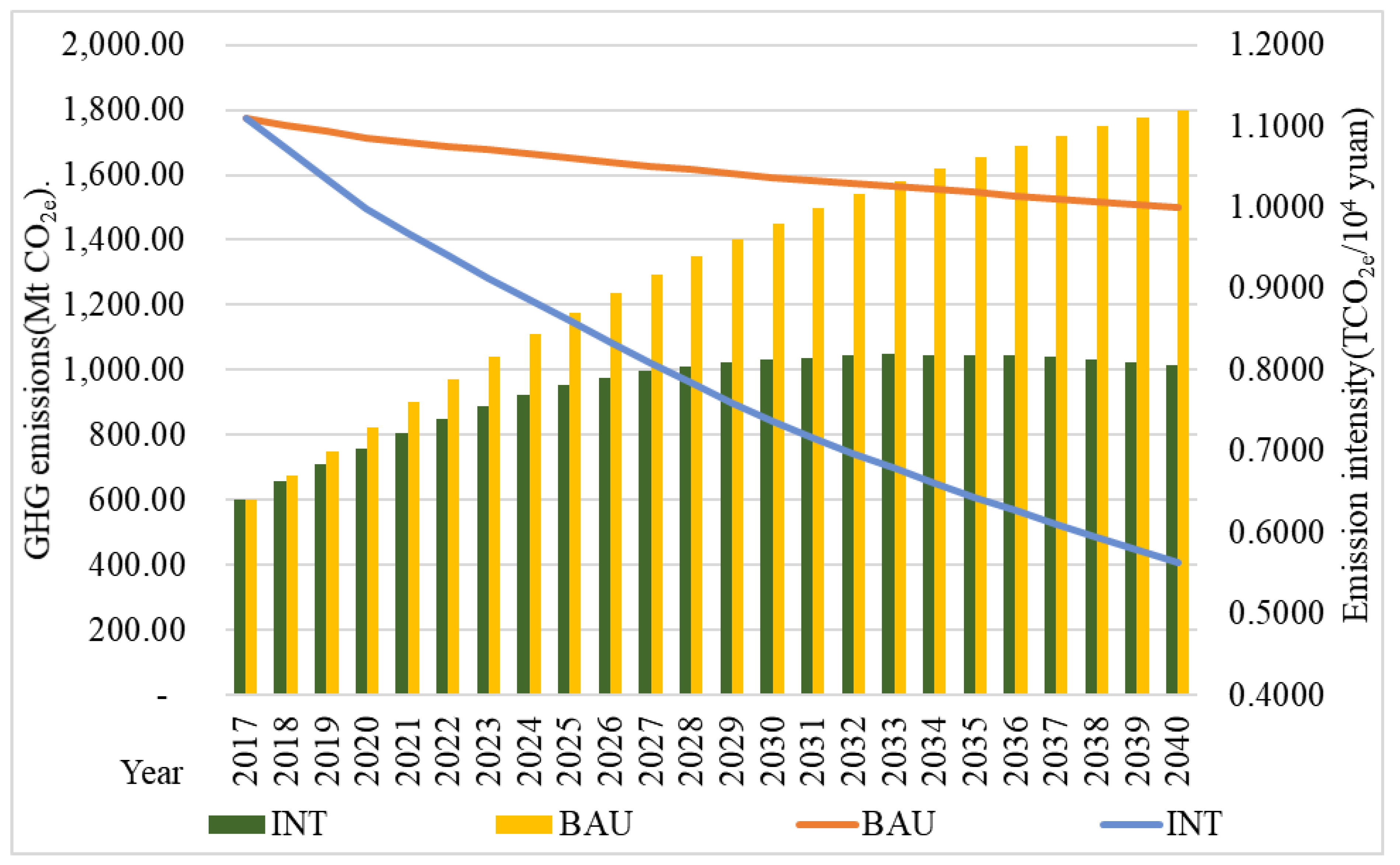
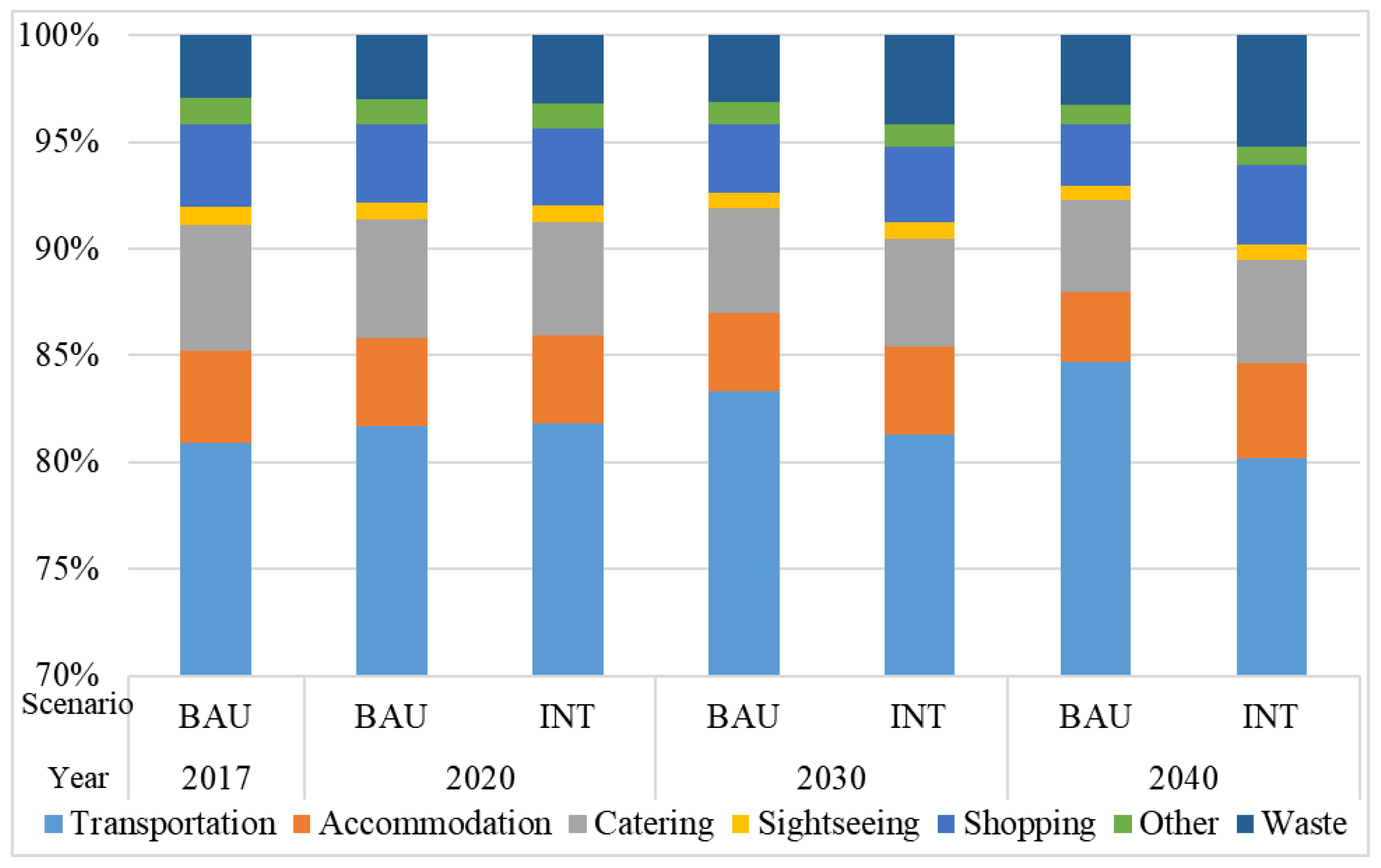
| Scenarios | Department Structure Optimization a | Clean Energy Substitution b | Energy Saving Facilities c | Low Carbon Behavior d | |||||||
|---|---|---|---|---|---|---|---|---|---|---|---|
| Sectors | 2017 | 2020 | 2030 | 2040 | 2017 | 2020 | 2030 | 2040 | |||
| Transportation | 36.60% | 36.00% | 34.00% | 30.00% | 8.17% | 10.00% | 15.00% | 20.00% | - | 1.0% annual reduction of fossil energy intensity, increase clean energy intensity by 2% annually | |
| Accommodation | 15.60% | 16.00% | 17.00% | 18.00% | 52.68% | 60.00% | 70.00% | 75.00% | 2.0% annual reduction of energy intensity | 1.0% annual reduction of energy intensity | |
| Catering | 20.99% | 21.00% | 21.50% | 22.00% | 52.76% | 2.0% annual reduction of energy intensity | |||||
| Shopping | 13.93% | 14.00% | 14.50% | 15.00% | 52.70% | 1.0% annual reduction of energy intensity | |||||
| Other | 7.59% | 8.00% | 8.50% | 9.00% | - | - | |||||
| Sightseeing | 5.29% | 5.50% | 5.80% | 6.00% | - | 1.0% annual reduction of energy intensity | |||||
| Waste | - | - | Reduce waste by 20% compared with the BAU scenario | Reduce waste by 10% compared with the BAU scenario | |||||||
| Power Generation | - | 73.50% | 60.00% | 35.00% | 20.00% | - | - | ||||
| Heat Supply | - | 100.00% | 80.00% | 60.00% | 40.00% | - | - | ||||
| Year | Transportation | Accommodation | Catering | Sightseeing | Shopping | Other | Total tourism revenue |
|---|---|---|---|---|---|---|---|
| 2017 | 19,766.35 | 8424.49 | 11,336.77 | 2857.42 | 7521.11 | 4097.55 | 54,003.69 |
| 2016 | 16,550.49 | 7408.16 | 10,965.71 | 2869.72 | 6589.83 | 2973.20 | 47,357.10 |
| 2015 | 13,407.81 | 5927.92 | 9458.00 | 2141.36 | 8127.07 | 2213.96 | 41,276.12 |
| 2014 | 10,982.70 | 4826.71 | 8298.93 | 1975.57 | 6311.56 | 1404.85 | 33,800.33 |
| 2013 | 9574.31 | 3688.86 | 7224.03 | 1545.25 | 6033.56 | 1413.20 | 29,479.21 |
| 2012 | 8314.59 | 3384.57 | 5960.67 | 1342.10 | 5486.25 | 1374.71 | 25,862.90 |
| 2011 | 7348.74 | 2957.74 | 4527.22 | 1168.77 | 5081.93 | 1351.72 | 22,436.11 |
| Year | 2011 | 2012 | 2013 | 2014 | 2015 | 2016 | 2017 |
|---|---|---|---|---|---|---|---|
| T | 1 | 2 | 3 | 4 | 5 | 6 | 7 |
| U | 0.0488 | 0.0952 | 0.1393 | 0.1813 | 0.2212 | 0.2592 | 0.2953 |
| Equation | Model Summary | Parameter | |||||||
|---|---|---|---|---|---|---|---|---|---|
| R2 | F | df1 | df2 | Sig. | Constant | b1 | b2 | b3 | |
| Linear | 0.9668 | 145.67 | 1 | 5 | 0.00 | 13,449.59 | 129,056.15 | ||
| Logarithmic | 0.8265 | 23.82 | 1 | 5 | 0.00 | 67,630.82 | 16,695.71 | ||
| Reciprocal | 0.6172 | 8.06 | 1 | 5 | 0.04 | 48,300.51 | −1512.71 | ||
| Quadratic | 0.9981 | 1055.11 | 2 | 4 | 0.00 | 20,956.71 | 16,428.10 | 326,334.50 | |
| Cubic | 0.9982 | 548.35 | 3 | 3 | 0.00 | 21,678.82 | −1861.93 | 448,942.86 | 237,473.50 |
| Power | 0.9011 | 45.55 | 1 | 5 | 0.00 | 86,017.36 | 0.48 | ||
| S | 0.7147 | 12.53 | 1 | 5 | 0.02 | 10.81 | −0.05 | ||
| Exponential | 0.9939 | 818.47 | 1 | 5 | 0.00 | 18,262.32 | 3.63 | ||
| Emission Reduction (Mt CO2e) | 2020 | 2030 | 2040 | 2050 | |
| 65.71 | 420.04 | 534.38 | 785.79 | ||
| Sub-scenarios | CES | 54.55% | 55.70% | 52.15% | 45.45% |
| LCB | 20.13% | 24.31% | 25.57% | 28.96% | |
| ESF | 17.82% | 13.77% | 13.70% | 13.52% | |
| DSO | 14.06% | 17.79% | 23.06% | 32.24% | |
| Sectors | Transportation | 80.04% | 88.41% | 89.83% | 90.48% |
| Accommodation | 4.49% | 2.35% | 1.92% | 1.75% | |
| Catering | 8.38% | 4.64% | 4.06% | 3.72% | |
| Sightseeing | 0.68% | 0.52% | 0.51% | 0.51% | |
| Shopping | 4.84% | 2.51% | 2.10% | 1.90% | |
| Other | 1.08% | 0.95% | 0.93% | 0.90% | |
| Waste | 0.49% | 0.61% | 0.65% | 0.75% | |
Publisher’s Note: MDPI stays neutral with regard to jurisdictional claims in published maps and institutional affiliations. |
© 2021 by the authors. Licensee MDPI, Basel, Switzerland. This article is an open access article distributed under the terms and conditions of the Creative Commons Attribution (CC BY) license (http://creativecommons.org/licenses/by/4.0/).
Share and Cite
Liu, D.; Yang, D.; Huang, A. LEAP-Based Greenhouse Gases Emissions Peak and Low Carbon Pathways in China’s Tourist Industry. Int. J. Environ. Res. Public Health 2021, 18, 1218. https://doi.org/10.3390/ijerph18031218
Liu D, Yang D, Huang A. LEAP-Based Greenhouse Gases Emissions Peak and Low Carbon Pathways in China’s Tourist Industry. International Journal of Environmental Research and Public Health. 2021; 18(3):1218. https://doi.org/10.3390/ijerph18031218
Chicago/Turabian StyleLiu, Dandan, Dewei Yang, and Anmin Huang. 2021. "LEAP-Based Greenhouse Gases Emissions Peak and Low Carbon Pathways in China’s Tourist Industry" International Journal of Environmental Research and Public Health 18, no. 3: 1218. https://doi.org/10.3390/ijerph18031218
APA StyleLiu, D., Yang, D., & Huang, A. (2021). LEAP-Based Greenhouse Gases Emissions Peak and Low Carbon Pathways in China’s Tourist Industry. International Journal of Environmental Research and Public Health, 18(3), 1218. https://doi.org/10.3390/ijerph18031218








